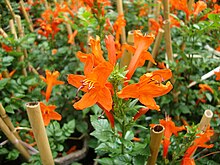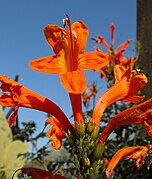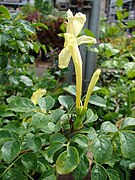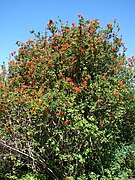Tecomaria capensis
| Tecomaria capensis | |
|---|---|

| |
| Scientific classification | |
| Kingdom: | Plantae |
| Clade: | Tracheophytes |
| Clade: | Angiosperms |
| Clade: | Eudicots |
| Clade: | Asterids |
| Order: | Lamiales |
| Family: | Bignoniaceae |
| Genus: | Tecomaria |
| Species: | T. capensis |
| Binomial name | |
| Tecomaria capensis | |
| Synonyms[3] | |
| |
Tecomaria capensis, the Cape honeysuckle,[4][5][6] is a species of flowering plant in the family Bignoniaceae, native to southern Africa.[7] Despite its common name, it is not closely related to the true honeysuckle.
Description

An erect, scrambling shrub, it grows to 2–3 m (7–10 ft) in height and a similar width. Normally evergreen, it may lose its leaves in colder climates. In certain habitats it may scramble, meaning that it shoots out long growth tips which lean on the stems and branches of other plants, as well as boulders, trellises, fences and walls; this can lead to the plant appearing untidy. The leaves are up to 15 cm (6 in) long. They are opposite, slightly serrated, green to dark-green, and pinnate with 5 to 9 oblong leaflets.
Flowers
The flowers are tubular, narrow, about 7.5 cm (3 in) long, and are produced erratically at different times throughout the year, though they typically bloom from autumn to spring.[8] They are grouped in 10–15 cm (4–6 in) long terminal clusters. The flower colour ranges from orange to orange-red to apricot.
Distribution
The species occurs naturally in parts of southern and central Africa, including South Africa, Eswatini, Mozambique, Malawi, Tanzania, Democratic Republic of the Congo, and Angola.[3]
It is cultivated in other areas of the world, such as in South-east Asia, the South of France, Hawaii, Florida, and California. It can be considered invasive in remote islands such as the Azores (as seen at the island of São Miguel, near Ponta Garça).
Cultivation
Tecomaria capensis has been in cultivation for many years and is often used for hedging, as it is a scrambling shrub. It can be propagated from cuttings or by removing rooted suckers during the active growth phase.
It can be planted in semi-shade to full sun. Tolerating temperatures down to 5 °C (41 °F), it can be grown in mild temperate areas with the protection of a warm wall.[9] Otherwise it can be grown in a container and taken indoors through the winter months. To keep this shrub clean and tidy, it must be pruned back in late winter to promote new growth and flowers. The application of a balanced fertilizer after pruning will enhance the growth and flowering.
This plant has gained the Royal Horticultural Society's Award of Garden Merit.[9][10]
Ecology
Tecomaria capensis is an excellent plant to use in a wildlife garden in Southern Africa, since it is popular with sunbirds and certain insects due to its nectar. As a scrambler, it can be quite dense (if pruned) and as such can be utilised as a nesting site by a few bird species.
The larvae of the death's head hawkmoth (Acherontia atropos) and the fulvous hawkmoth (Coelonia mauritii) eat the leaves of this plant.
Gallery
- Habitus
- Close-up of flower
- Yellow variety
- Shrub
- Maui, Enchanting Floral Gardens of Kula
- Large shrub
- Small tree
References
- ^ Botanic Gardens Conservation International (BGCI).; IUCN SSC Global Tree Specialist Group. (2020). "Tecoma capensis". IUCN Red List of Threatened Species. 2020: e.T82858988A146440991. doi:10.2305/IUCN.UK.2020-2.RLTS.T82858988A146440991.en. Retrieved 18 October 2023.
- ^ Foden, W. & Potter, L. 2005. Tecomaria capensis (Thunb.) Spach. National Assessment: Red List of South African Plants version 2020.1. Accessed on 18 October 2023.
- ^ a b Tecomaria capensis (Thunb.) Spach. Plants of the World Online. Retrieved 18 October 2023.
- ^ NRCS. "Tecoma capensis". PLANTS Database. United States Department of Agriculture (USDA). Retrieved 8 December 2015.
- ^ "Tecomaria capensis". Germplasm Resources Information Network. Agricultural Research Service, United States Department of Agriculture. Retrieved 14 January 2018.
- ^ "Tecomaria capensis | PlantZAfrica.com". www.plantzafrica.com. Retrieved 2017-08-16.[1]
- ^ RHS A-Z encyclopedia of garden plants. United Kingdom: Dorling Kindersley. 2008. p. 1136. ISBN 978-1405332965.
- ^ Tecoma capensis North Carolina Extension Gardener Plant Toolbox. NC State University. Retrieved 24 January 2024.
- ^ a b "RHS Plant Selector - Tecoma capensis". RHS. Retrieved 5 March 2021.
- ^ "AGM Plants - Ornamental" (PDF). Royal Horticultural Society. July 2017. p. 100. Retrieved 1 December 2018.
![]() Media related to Tecoma capensis at Wikimedia Commons
Media related to Tecoma capensis at Wikimedia Commons









